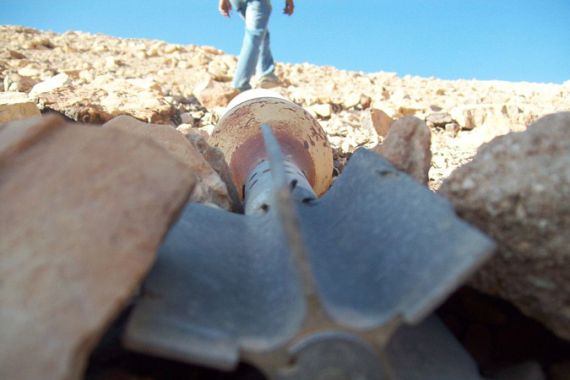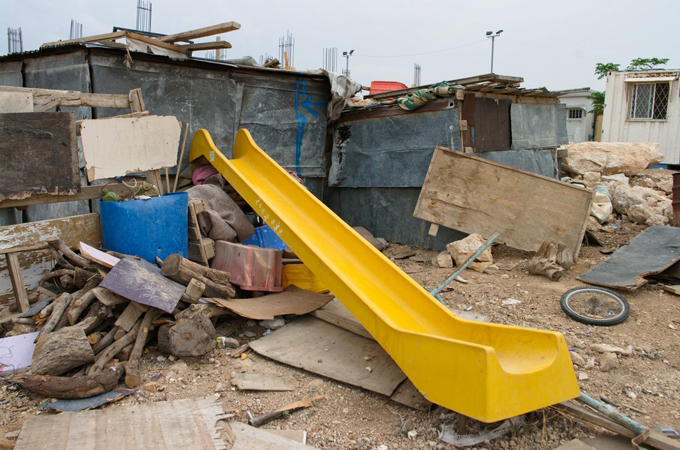No country for old Bedou men
Traditional Bedouin communities are at a “breaking point” in Israel and Palestine. They now face an impossible dilemma.

 |
|
Al-Aizariya camp, home to 3,000 Jahalin Bedouin. The community have lived here since 1997, when they agreed to move from the current location of Ma’ale Adummim settlement [Photo credit: Lazar Simeonov] |
Amid the rubble of Al-Aizariya you can see the fruits of compromise.
This shanty town of 3,000 Jahalin Bedouin lies just south of Jerusalem, a short walk from the city’s main garbage dump.
They are housed in scrap-metal shacks without water or electricity. Grazing animals, their primary source of income, bring diseases from the chemical waste nearby. Modern, permanent housing is slowly beginning to appear.
Despite these conditions, most Bedouin communities in Israel and Palestine would trade places in a heartbeat.
While unrecognised villages in the Negev and the Jordan Valley face new waves of demolitions, the Jahalin possess that most precious and elusive commodity: security.
Like the vast majority of Bedouins in the region, the residents of Al-Aizariya were based in the Negev until the Nakbah of 1948 forced them out.
They arrived here in 1997, via a second displacement on land now occupied by the Ma’ale Adummim settlement.
In return for their voluntary departure they were given around $10,000 compensation per family. More importantly, they were granted the rights to this wretched piece of land and eventually the right to build – today, there stands a modest school and health clinic.
The price of compromise
Their deal-making with Israel has come at the cost of their traditions and independence. Agriculture is near impossible on this barren earth, leaving them reliant on Israeli support which rarely arrives.
“They promised us electricity, water and streets, but when we came here there was nothing,” reflects Eid Abu Raeb, the town’s founder and co-ordinator, “for the last ten years they have been promising to relocate the garbage dump.”
The unsatisfactory agreement reflects a lack of faith in the alternatives. Bedouin communities have only recently become a focus for human rights campaigns, and they are not readily accepted into Palestinian society.
In the face of Israel’s ferocious, co-ordinated campaign of ethnic cleansing against Bedouins on both sides of the Green Line, one can understand Abu Raeb’s decision not to fight against overwhelming odds.
The threats are mounting for communities elsewhere. On March 10, Ramat Negev Council chairman Shmulik Rifman announced his intention to house “700,000 Jews in the Negev” at the expense of its indigenous community.
His statement followed the bulldozing of Al-Araqeeb on February 17, for the 18th time, leaving 300 Bedouins homeless. There are 36 unrecognised villages in the desert, leaving around 80,000 vulnerable to the same fate.
The largest of these, Wadi El Na’am, represents a more sinister side of Israeli displacement attempts.
Since 1979, government attempts to buy out Bedouin residents have been supplemented by heavy industrialisation around the village including chemical factories and a toxic waste incinerator.
Cancer, asthma and miscarriage cases have been high ever since, and though pylons run dangerously through the village, electricity – along with water and healthcare – is not provided for residents.
The government hopes that Bedouins will feel pressured into accepting the recommendations of the March 11 Goldberg Report, drafted without consultation of the affected communities.
It contains a plan to buy half of all Bedouin land in the Negev and shunt occupants into purpose-built townships.
Expropriation
It is a measure of official disdain for Bedouins that conditions in these townships are even worse than in the unrecognised villages.
Most of Wadi El Na’am residents are desperate to escape, but few have been tempted by an offer of relocation to the run-down Segev Shalom township.
The policy of applying pressure by attacking quality of life is also common in the West Bank. In Area C, controlled by Israeli military law, it is normal for the army to commandeer large areas for ‘training zones’, with little regard for the communities they infringe upon.
One of these is Al-Rashayida village, near Bethlehem, which has lost half its land to an unfenced, unmarked training zone dotted with deadly explosives.
Bedouin shepherd Awad Al-Rashayid was crippled by one last year, along with many of his neighbours. He believes the injuries stem from a deliberate policy.
“They (the army) don’t make it safe because they want the land. They want us to leave to make space for settlers.”
In a region swamped with NGOs, advocacy support for Bedouins has been conspicuously light.
Their isolation in remote areas has contributed to a low profile, but the only Bedouin Knesset member, Taleb El-Sana, told us that their cause has been buried under the Israel-Palestine conflict.
“We have no real representation,” he said in an interview, “people always speak about the occupation but nobody hears about the Bedouin.”
In the Negev at least, representation has improved in recent years. The Regional Council for Unrecognised Villages (RCUV) and Bustan, both established in the late 1990s, campaign on behalf of the 36 villages, while promoting education and development within them.
Their efforts have given fresh impetus to what had seemed a lost cause, using better strategy and realistic goals.
“We feel the situation is close to breaking point,” says Michael Zak of RCUV. “The government’s plan (Goldberg) to link land ownership with basic rights is unacceptable, we will deal with the ownership question in a better future. For now we want the basic rights that every Israeli citizen is entitled to.”
These basic rights denied to unrecognised villages include the critical services of water, healthcare and education. Physicians for Human Rights report 30 per cent have no running water at all, while 34 of the 36 villages have no access to medical services.
The report describes this deprivation as a “means to forcibly concentrate the Arab-Bedouin population in the state-planned towns.”
Poor education facilities which force children to walk many miles to school each day have contributed to mass unemployment and a staggering poverty rate of 80 per cent. It is a stark illustration of how marginalised these communities have become.
The question of alliegance
If these injustices are beginning to gain recognition in Israel, there is little support for Bedouin rights in the West Bank.
This partly stems from the suspicion with which they are widely viewed by Palestinians. Abu Raeb explained one of the reasons: “When we were under Jordanian rule, we were with Jordan,” he told us. “When the Israelis are in charge, we are with them.”
This lack of political allegiance has cost Bedouins goodwill from Palestinians who expect solidarity.
“They should not accept to live on occupied land,” says Abdullah, a Palestinian from neighbouring Abu Dis, of the Al-Aizariya Bedouins, “we think very badly of them.”
I hear stronger terms like ‘spy’ and ‘traitor’ from other Abu Dis residents.
Making deals with the Israeli government and integrating into Israeli society, even to the extent of voluntarily joining the army, has widened the divide between Bedouins and Palestinians. The Jordan Valley, home to the largest Palestinian Bedouin population, is effectively cut off from the West Bank and has just one dedicated NGO. MK El-Sana calls it a “double persecution”.
In the most fiercely contested piece of land in the world, a passive approach has not worked. The lack of political involvement has cost Bedouins, and there is now a belated effort to take ownership of their cause.
The unrecognised villages of the Negev are pushing for elections, and are expected to reject the government’s offer for their land. Michel Zak tells us less than 1 per cent now volunteer for the army, indicating a new desire to secure legitimacy on their own terms.
Increased political activity is coupled with attempts to come in from the margins by updating their traditions.
“Bedouins want to be a part of modern life,” says El-Sana, “to integrate technology and improve academic standards.”
Such plans are supported by local NGOs, who have secured EU funding for development work. In Egypt and Jordan, where Bedouins are governed more sympathetically, communities have prospered through the tourist trade.
The Wadi Rum in Jordan has become a honey-pot destination for visitors keen to experience traditional Bedouin culture.
Such a future has little hope amid the chaos of the Israel-Palestine conflict. It seems Bedouins must adapt or suffer continued ethnic cleansing.
“It is not a crime to be a Bedouin,” says El-Sana, but their treatment here suggests it might as well be.
Bedouin communities face an almost impossible decision: to fight state persecution, or to limp on in reduced circumstances as they do in Al-Aizariya. Both routes are paved with peril.
Kieron Monks is content manager of This Week in Palestine magazine. His freelance articles have appeared in The Guardian, Observer, New Statesman, Tribune, Ma’an News and many others.